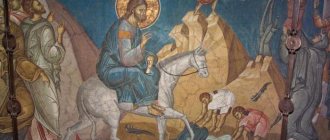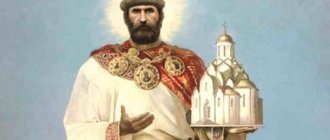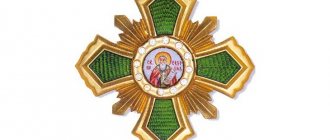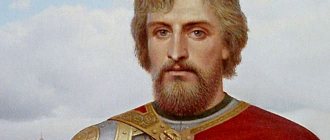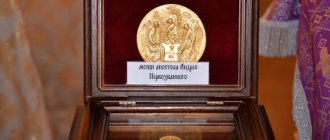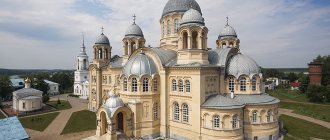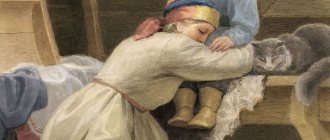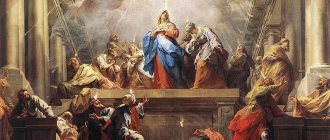Andrei Bogolyubsky (1111–1174) is one of the most unique rulers of Ancient Rus':
• Son of Yuri Dolgoruky - the founder of Moscow and the Polovtsian princess, daughter of Khan Aepa Osekevich.
• He united the Russian lands under his rule, founding the Vladimir-Suzdal principality in the 12th century, which gave rise to Moscow Rus' in the 14th century, which became an empire in the 18th century, and the Soviet Union in the 20th century.
• In 1155 he brought to Vladimir the icon of the Vyshgorod Mother of God, which later received the name Vladimir and became the palladium of Russia.
• The founder of Russian white stone architecture, whose architectural monuments still delight the world community and are included in the UNESCO list.
• Bogolyubovo is the favorite residence of Andrei Bogolyubsky, from the name of which he received his nickname. Under Prince Andrei, the famous Church of the Intercession on the Nerl was built near Bogolyubovo.
• In 1169, he defeated Kyiv, where his father had previously been poisoned, and moved the capital of the Russian land to Vladimir, thereby ending the century of Kievan Rus, founded by Oleg the Prophet in the 9th century.
• On the initiative of the prince, new holidays for Rus' were established - the Savior (August 14, Honey Spas) and the Intercession of the Blessed Virgin Mary (October 14).
• During his reign, Veliky Ustyug became the northeastern outpost of the Vladimir-Suzdal principality, which fought for the northern lands with Veliky Novgorod.
• Killed in 1174 by a group of conspirators, buried in the Assumption Cathedral in Vladimir.
• Canonized by the Russian Orthodox Church in the 18th century.
II. Biography
Andrey Bogolyubsky, reconstruction by M. M. Gerasimov
Andrei Bogolyubsky (1111–1174) - the son of Yuri Dolgoruky and the Polovtsian princess, the grandson of Vladimir Monomakh, whose grandfather, in turn, was Yaroslav the Wise - the son of the Kyiv prince Vladimir - the Baptist of Rus', known in Russian folklore as the Red Sun.
We can safely say about Andrei Bogolyubsky that he was an outstanding and wise statesman. As a warrior and commander, he was always distinguished by courage and courage, he left a deep mark on Russian history. For the successful unification of Russian lands under his rule, his merciless struggle against the feudal fragmentation of the state into appanage principalities, he is called the first, but not crowned, Tsar of Rus'. For the first time in the history of Rus', the custom of marrying into the kingdom was officially introduced by Ivan the Terrible in 1547.
Andrei took an active part in the military campaigns of his father Yuri Dolgoruky, the founder of Moscow, the same age as Veliky Ustyug (1147). Seeing the beginning of the disintegration of the Russian land into independent principalities and brutal internecine wars, in 1155 Andrei left Kyiv (Vyshgorod) for his beloved Suzdal lands. Andrey devoted all his strength to strengthening them.
In 1169, he defeated Kyiv and moved the capital of the Russian state to Vladimir. Vladimir becomes the political center of Rus', and Andrei Bogolyubsky becomes the first Russian Grand Duke. Paying tribute to Vladimir as the first Russian capital, many Russian autocrats visited it more than once, including Ivan the Terrible and Peter I.
P. _ S. _ In the 16th century, during the reign of Ivan the Terrible, the Vladimir Nativity Monastery, which was the main spiritual monastery of the country, gives way to the Trinity-Sergeev Monastery (Sergiev Posad). In 1724, by order of Peter I, from the Vladimir Nativity Monastery to the new capital he founded on the Nile meridian - St. Petersburg, the relics of Prince Alexander Nevsky, who defeated the Swedes in 1240 at the mouth of the Izhora River (at the confluence with the Neva) were transferred to the Alexander Nevsky Lavra ( for which he received the title “Nevsky”) and became the heavenly patron of the city on the Neva.
Holy Blessed Prince Andrei Bogolyubsky (icon)
During the reign of Andrei Bogolyubsky, the importance of North-Eastern Rus' grows, the power of the Vladimir-Suzdal principality strengthens, it becomes the strongest in Rus'. For the further rise of the new capital, Prince Andrei decided to have an independent bishop and even a Metropolitan. The bishop's chair was transferred here from Rostov. This caused strong indignation among the Rostov nobility and clergy. The strengthening of princely power and the conflict with prominent boyars, the strengthening and expansion of Vladimir, the policy of unifying the fragmented Russian lands - all these actions of Andrei Bogolyubsky gave rise to a boyar conspiracy against him, in which (according to the Life) his own wife and her siblings also participated.
In June 1174, the conspirators treacherously entered Andrei's chambers and killed him. Later, after a popular revolt, Andrei was buried in a stone tomb of the Assumption Cathedral he built in Vladimir. He was later canonized by the Russian Orthodox Church.
One of the sons of Andrei Bogolyubsky - Prince Yuri (George in baptism) was married to the Georgian queen Tamara.
Vladimir Icon of the Mother of God (Tretyakov Gallery)
Andrei Bogolyubsky is directly connected with the Vladimir Icon of the Mother of God, in honor of whose meeting the Sretensky Monastery was built in Moscow. According to legend, the image of the Vladimir Icon of the Mother of God was written by the Evangelist Luke on a board from the table at which Jesus Christ himself ate with his mother Mary and father Joseph.
In the 5th century, the icon came from Jerusalem to Constantinople. In the 12th century, during the reign of Yuri Dolgoruky, the Patriarch of Constantinople Chrysoverg sent it as a gift to Rus'. The icon was placed in the Maiden Monastery of Vyshgorod (10 km from Kyiv), which was given by Yuri Dolgoruky to his son Andrei Bogolyubsky for appanage rule in 1155, after its final approval in Kyiv. In history, Vyshgorod is known for the fact that it was previously the appanage city of Grand Duchess Olga, the grandmother of Vladimir the Baptist of Rus', who converted to Christianity in Constantinople.
Assumption Cathedral in Vladimir
Tired of useless internecine wars, Andrei Bogolyubsky left Vyshgorod in 1155 and headed to his beloved Suzdal land. He takes this icon with him to Vladimir, his new capital, and places it in the famous Assumption Cathedral he erected, which amazed everyone with its wealth and splendor. From that time on, the icon received the name Vladimir. During the transfer of this icon from Vyshgorod to Vladimir, Andrei Bogolyubsky had an appearance of the Mother of God. Soon the city of Vladimir (which rules the world) became the capital of North-Eastern Rus', and then of the entire Russian land. This is how the spiritual ties between Byzantium and Rus' were cemented - through Kyiv, Vladimir and Moscow.
In 1395, the icon was brought to Moscow for the first time, which, according to legend, saved the capital from destruction by the Samarkand ruler Timur. It is also believed that the prayers of the Vladimir Icon in 1430 stopped the Khan of the Golden Horde, Akhmat, with his huge hordes, moving towards Rus' (the famous position on the Ugra). The Russian troops were commanded by Grand Duke Ivan III (1462-1505) - the grandfather of Ivan the Terrible, the husband of Sophia Paleologus - the niece of the last emperor of Byzantium, Constantine. It is believed that through her the double-headed eagle and other attributes of the Byzantine emperors came to Rus' from Byzantium. As a woman and a subtle politician, with her intelligence and experience she had a huge influence on the centralization of Russian lands, continued after Andrei Bogolyubsky, albeit with a break of more than 300 years, by Ivan III, and then by his son Vasily III and grandson Ivan the Terrible.
Text and rules of prayer before the icon of the holy prince
The text of the prayer written about Andrei Bogolyubsky says how very pious and faithful he is before the Lord. This prayer especially helps people in authority.
But ordinary people also pray and ask for help from the noble prince.
“Oh, holy blessed Grand Duke Andrei Bogolyubsky! A faithful and God-glorifying servant of God, a devout and jealous Christian, a virtuous and God-wise man, an all-honorable warrior and a good commander, a sovereign and daring ruler! Holy Rus' divided into appanages and principalities, who, by God's will, wants to gather into a single Russian Kingdom and rule it as a sovereign, so that it may remain invincible from all enemies, visible and invisible, who rise up against Orthodox Christians. May your holy deeds not be in vain for the glory and honor of the Christian God, where we see and magnify your God-blessed structure of the God-loved Orthodox Kingdom on the Russian Land, when you erected the capital city of Vladimir and the God-loving monastery of the Most Holy Theotokos, where you are in it in the middle of the night innocently wicked and perjured taken by his servants and killed at their hands unlawfully and with the cruelest swords, and bleeding with his honest blood, thus laying a solid foundation for the Unity of Orthodox Rus'. And now we, sinful servants of God (names), believe in your God-powerful heavenly intercession, for having sealed your life with a martyr’s crown, we pray to you that the Lord will deliver us from the sedition of the servants of the Antichrist and from bloody sacrifices and Jewish customs, and may the Russian Land be saved from the yoke of Satan, for we have you, the great saint of God, the undaunted warrior of Christ, who always fought on the fields of earthly battle with many enemies for the Holy Faith and the Fatherland, and who showed such a wondrous glory of God’s victories to the entire Russian Land. And you, as a sovereign commander and holy martyr, and always a daring prayer book for us, God-loving and tireless creator of Holy Rus', wonderfully glorified in the holy relics, and left to help and intercede for us, arise for us against foreign, foreign and harmful adversaries, and resist them with many holy prince-warriors, and first with the holy Equal-to-the-Apostles Grand Duke Vladimir and the holy Equal-to-the-Apostles Grand Duchess Olga, and with the great noble princes, the first martyrs-martyrs Boris and Gleb, and with the holy warrior Venerable Martyr Igor of Chernigov, and the holy noble great prince George Vsevolodovich of Vladimir, together with your God-blessed sons, prince-martyrs Gleb of Vladimir and the brave Izyaslav, may the House of the Most Holy Theotokos, the Sovereign Lady of all Rus', be unshakable with their help, and may the Russian Land be glorified and shine through you, Prince Andrei, forever and will be filled with a pious Christian family with the blessing of the Mother of God, and the Grace of Her many-miracle-working icons of Vladimir and Bogolyubskaya, and again the glory of Orthodox Rus' will be cherished and strengthened, and will shine with the Immaterial and Life-Giving Light of God the Father, the Son and the Holy Spirit. Amen".
The main rule of this prayer is that it helps most twice a year. These days are November 11 and June 5.
IV. Bogolyubskaya Icon of the Mother of God
Bogolyubskaya Icon of the Mother of God
Appearance of the Mother of God to Prince Andrei Bogolyubsky
Bogolyubskaya icon of the Mother of God, painted in the 12th century. commissioned by Andrei Bogolyubsky - one of the oldest miraculous icons in Russia. The history of its appearance is directly connected with him and the Vladimir Icon of the Mother of God.
According to legend, in 1155 Andrei Bogolyubsky left Vyshgorod (Kyiv) for the Suzdal lands and took with him the local shrine - the miraculous icon of the Mother of God, which later became the Vladimir Icon.
Legend has it that not far from Vladimir, on the banks of the Nerl, the horses carrying the icon case with the miraculous icon stopped and could not move. The prince settled down here for the night. And he had a dream in which the Mother of God pointed out to Andrey
Church of the Nativity of the Virgin Mary (right)
to Vladimir as the new center of Rus', ordering the transported Vyshgorod icon to be installed in it, and advised to erect a church at the place of the overnight stay.
Bogolyubovsky Monastery
At the site of the appearance of the Mother of God, Prince Andrei built the Church of the Nativity of the Virgin Mary and created his residence, called Bogolyubovo - a place beloved by God (now the village of Bogolyubovo). The Bogolyubov Monastery, one of the most ancient monasteries in Russia, also grew up here. The main shrine of the monastery was the Bogolyubsk Icon of the Mother of God, the same one that Prince Andrei Bogolyubsky ordered after a miraculous sign off the banks of the Nerl, as it appeared to him: in full height, with a scroll in her right hand and her face turned to Jesus Christ.
V. Kuchkovo field
Bogolyubsky Monastery: The tower of the former palace with the chambers of Andrei Bogolyubsky (left), in which Andrei Bogolyubsky was killed in 1174. Church of the Nativity of the Virgin Mary (right), built by the prince on the site of the appearance of the Mother of God to him.
Kuchkovo Field is an area in the north of central Moscow, between modern Lubyanka Square and Sretensky Gate (according to another version, between Sretensky Gate and Chistye Prudy). The name has been known since the 14th century and is associated with the name of the semi-legendary rich boyar S.I. Kuchka, who owned in the middle of the 12th century. lands on the territory of the future Moscow. In 1397, the Sretensky Monastery was built on Kuchkovo Field. In the XII-XV centuries. the road to Vladimir (later Bolshaya Lubyanka Street) passed through Kuchkovo Field. The name “Kuchkovo Field” disappears in the 16th–17th centuries.
Boyar Kuchka and the field named after him are associated with Yuri Dolgoruky and his son Andrei Bogolyubsky. According to some sources, boyar Kuchka was forcibly deprived of his possessions by the founder of Moscow, Yuri Dolgoruky, and his sons were persecuted by Andrei Bogolyubsky for their misdeeds. According to one version, the wife of Andrei Bogolyubsky was the daughter of the boyar Kuchka, Ulyana, who, together with her brothers, the sons of Kuchka, was part of a group of conspirators (although today other versions appear).
On a summer night in 1174, conspirators numbering about twenty people made their way to Andrei’s palace in Bogolyubovo, killed the small number of guards and broke into the bedroom of the unarmed prince. The sword hanging over his bed was treacherously stolen that night by a bribed servant. The strong Bogolyubsky resisted for a long time. The prince managed to throw the first of the attackers to the floor, whom his accomplices immediately mistakenly pierced with swords. But they soon realized their mistake - the spear pierced the side of Andrei’s forehead, all the other blows were delivered by the cowardly killers from behind. When the prince, wounded and bloodied under the blows of the killers, finally fell, they rushed out of his chambers, capturing their murdered accomplice.
But Bogolyubsky was still alive. With his last effort, he went down the palace stairs, hoping to call the guards, but his groans were heard by the killers and they turned back in horror. The prince managed to hide in a niche under the stairs and miss them. The conspirators ran into the bedroom and did not find the prince there. In fear, they lit candles and followed the bloody trail to find and finish off the exhausted prince. Later, Andrei Bogolyubsky was canonized by the Russian Orthodox Church.
VI. Architecture
During the reign of Andrei Bogolyubsky, white stone construction in Vladimir was truly widespread. On the site of the ancient wooden Church of the Assumption of the Blessed Virgin Mary, construction of the white-stone Assumption Cathedral began in 1158. According to the prince’s plan, it was built not only as a temple for the Vladimir principality, but also as the main temple of all Rus'.
During his reign from 1157 to 1174, Andrei Bogolyubsky built many monasteries and temples, in particular in Vladimir he built the Assumption Cathedral (1158–1160), the Golden Gate (1158–1164), and a country palace in Bogolyubovo ( 1158–1165), the amazingly beautiful Church of the Intercession on the Nerl (1165).
Assumption Cathedral (1158–1160)
In 1158, Andrei Bogolyubsky made the city of Vladimir his capital; in the same year, on a high mountain above the Klyazma River, he began to build the Assumption Cathedral - the main temple of his principality, which became the main temple of North-Eastern or “Zalessky” Rus'. The cathedral became the largest building of the new capital, the center of its architectural ensemble. Andrei Bogolyubsky conceived his temple not only as the main cathedral of the Vladimir bishopric, but also as a stronghold of a new metropolitanate, independent of Kyiv. The Assumption Cathedral was probably built by an artel of European masters of Romanesque architecture, sent by Emperor Frederick Barbarossa. According to the chronicle, “God brought craftsmen from all lands.”
Andrei Bogolyubsky, like Vladimir the Red Sun, considered the founder of the city of Vladimir, allocated large land holdings and a tenth of his income to the Assumption Cathedral. To the left of the royal gates of the cathedral was placed an icon of the Vladimir Mother of God, taken by Prince Andrei from Vyshgorod. Today the icon is kept in the Tretyakov Gallery, in the Church of St. Nicholas in Tolmachi.
The architecture of the Vladimir Assumption Cathedral determined the development of architecture in North-Eastern Rus' for several centuries to come. The entire architecture of the Moscow state grew from it. The famous white stone carvings of ancient Russian churches also originate from the walls of the Assumption Cathedral. Prince Andrei Bogolyubsky, his sons Gleb and Izyaslav, his younger brother, the Grand Duke of Vladimir Vsevolod the Big Nest, and other associates of North-Eastern Rus' were buried in the Vladimir Assumption Cathedral.
In the winter of 1383, in the Vladimir Assumption Cathedral, by the will of Grand Duke Dmitry Donskoy, Metropolitan Pimen ordained Stefan of Perm, the greatest educator, missionary and statesman of Ancient Rus', a close friend of Sergius of Radonezh, to the rank of bishop.
Golden Gate (1158–1164)
This is a rare monument of Russian military-defensive architecture from the reign of Andrei Bogolyubsky. They were built in 1164, when the construction of the grandiose line of ramparts of the New City was completed and were the main stone gates of its wooden fortifications. In beauty and grandeur they surpassed the Kyiv Golden Gate. They were the main entrance to the city and a powerful defensive structure.
But the construction of the Golden Gate also had another, special meaning - it is a symbol of the new capital status of Vladimir, because the Golden Gates were also in Constantinople (Constantinople, now Istanbul), in Jerusalem, in Kiev, i.e. in the main Christian cities, and centers of political and military power of his time.
The Golden Gate in Jerusalem is famous for the fact that Jesus entered it before Easter. According to prophecy, Jesus will enter these Golden Gates before the end of the world.
| Golden Gate in Jerusalem | Golden Gate in Istanbul | Golden Gate in Kyiv |
Intercession on the Nerl (1165)
The Church of the Intercession on the Nerl is a true masterpiece of world architecture. Those who say that anyone who has seen this temple at least once can no longer say that there were no happy moments in his life are right...
The place for construction was indicated by Andrei Bogolyubsky. The temple is a monument to the memory of the victorious campaign of Andrei Bogolyubsky against the Volga Bulgars. According to legend, the stone for the construction was brought from Bulgaria. At the same time, it became a monument to Andrei’s son Izyaslav, who died in this campaign. The temple is dedicated to the Feast of the Intercession of the Virgin Mary, established by Andrei Bogolyubsky and which became one of the most beloved in Rus'.
Boundaries: do they matter much?
Andrei Bogolyubsky, who was prone to autocracy, soon ceased to fit within the boundaries of the zone of rule given to him. Already at the end of the 60s of his reign, the interests of the Grand Duke went far beyond the boundaries of the original area. In 59-67 in Kyiv, the princely throne was occupied by Rostislav of Smolensky, who was Andrei’s cousin, and who was also older than him. At this time, the grouping of the princes of Volyn, Kyiv and Smolensk was strong enough to regulate the balance in the field of politics. When Rostislav died, it became obvious to everyone: Andrei’s forces were more significant than any potential opponents.
In many ways, active actions were provoked by the prince from Volyn Mstislav, who took advantage of the help of the Poles and Galician troops and headed for Kyiv in order to capture the capital city. In response, Andrei Bogolyubsky organized as many as 11 princes, including the sons of the deceased, the closest associates of Andrei himself, the Smolensk and Chernigov rulers, and the prince from Dorogobuzh. Even then it was possible to talk about a powerful coalition, and Andrei, in the future named a saint, became its spiritual center, head and heart.
VII. Sretensky Monastery and Timur
Cathedral of the Presentation of the Icon of the Vladimir Mother of God of the Sretensky Monastery
Sretensky Monastery stands on the seventh (of seven) hills of Moscow. The monastery is directly connected with the icon of the Mother of God brought to Rus' by Andrei Bogolyubsky, which was called the Vladimir icon. It was founded in 1397 by Grand Duke Vasily, the son of Dmitry Donskoy on Kuchkovo Field, at the site of the meeting (contemplation) in 1395 by Muscovites of the icon of Our Lady of Vladimir, transferred from Vladimir to Moscow in anticipation of Timur's invasion.
The Battle of Kulikovo in 1380 brought victory over Temnik Mamai, who at that time seized power in the Golden Horde. In 1382, after Tokhtamysh seized power in the Horde and took Moscow (Dmitry Donskoy then took refuge in Kostroma), Rus' resumed paying tribute.
In 1391, near Samara, on the Kondurcha River (the village of Stary Buyan), Timur defeated the troops of Tokhtamysh for the first time, significantly undermining the power of the Golden Horde.
The second and complete defeat of Timur, Khan of the Golden Horde Tokhtamysh, occurred again on the territory of modern Russia, in the North Caucasus (on the Malka River) in 1395. Since at that time Rus' was still a tributary (vassal) of the Golden Horde, Tokhtamysh’s retreat passed through Russian lands. Timur's invincible army followed in his footsteps. Understanding the inevitable death of the capital, Muscovites could only rely on the help of the Russian intercessor - the Mother of God. For this purpose, a delegation was sent from Moscow to Vladimir to bring the miraculous Vladimir Icon, which stood at the origins of Russian statehood, to the new capital of Rus'.
According to the chronicles, on the day when the delegation brought the icon to Moscow from Vladimir, Timur, who reached Yelets with his army, had a dream in which the Mother of God demanded that he leave the borders of Rus'. Having not lost a single battle, and being a man with highly developed intuition, Timur correctly interpreted the phenomenon and turned his troops home to Samarkand.
Sretensky Monastery belonged to the so-called “northern defensive line”, allowing control of the road to Yaroslavl. In 1552, Muscovites met the Russian army at its walls, returning after the capture of Kazan by Ivan the Terrible.
After the October Revolution of 1917, the monastery was abolished, and in 1928-1930 most of its buildings were demolished. At the same time, two of the three churches located on the territory of the monastery were completely destroyed. Only the Cathedral of the Presentation of the Icon of the Vladimir Mother of God, built in 1679, and the cells of the monastery dating back to the 17th-18th centuries have survived. At the beginning of 1991, Sretensky Monastery was transferred to the Russian Orthodox Church.
Russia owes a lot to the Samarkand ruler Timur, who finally defeated the Golden Horde in 1395, and with whose name the Sretensky Monastery is associated, one of the most famous and ancient monasteries in Moscow. The World Channeling magazine gives information about the transformation of the conqueror Timur into Tamerlane (He who knows Merlin).
In short, Timur made it possible for Rus':
• Become an independent state in the 15th century, stopping paying tribute to the Horde.
• During the 16th century, gather under your control the former lands of the Golden Horde - the Kazan, Astrakhan, Siberian Khanates, etc.
• Become an empire in the 18th century.
• In the 20th century become the Soviet Union.
VIII. Ivan groznyj
Andrei Bogolyubsky and Ivan the Terrible saw the narrow-mindedness and greed of the boyars who were tearing the Russian lands into appanage principalities. Both rulers sought to strengthen autocratic power as a way to strengthen the military power of the state and the morale of the people.
Andrei Bogolyubsky began the fight against the noble boyars, abolishing the system of appanages and surrounding himself with new service people to strengthen the state apparatus. Ivan the Terrible finally liquidated the appanage principalities, the last of which was Staritsky.
Church of the Intercession on the Moat (St. Basil's)
Andrei Bogolyubsky is called the first, but not crowned, Russian Tsar, while the first ruler in Russian history to be crowned king was Ivan the Terrible, another famous Rurikovich, in 1547. With the capture of Kazan, he completed the work begun by Andrei Bogolyubsky: the Volga, the main waterway of the country, became a Russian river. Returning after the conquest of Kazan, messengers informed Ivan the Terrible not far from Vladimir about the birth of his first child, Tsarevich Dmitry.
In 1165, by order of Andrei Bogolyubsky, near Vladimir, the most talented architects erected the Temple of the Intercession on the Nerl - a monument to the victory of Russian soldiers in Prince Andrei’s campaign against Volga Bulgaria (modern Tatarstan) and to his deceased son, which became a masterpiece of world architecture.
Cathedral of the Assumption of the Mother of God in the Staritsky Assumption Monastery
After 387 years in Moscow, Barma and Postnik, on the orders of Ivan the Terrible, created the unprecedentedly beautiful Church of the Intercession on the Moat (or St. Basil's Cathedral) in honor of the capture of Kazan.
The name “Intercession” for the Moscow Temple was not chosen by chance - on the day of the Intercession of the Virgin Mary (October 14 - according to the new style), a decisive assault on the city of Kazan began.
It is known that Ivan the Terrible loved to visit Vladimir, the capital of the principality of Andrei Bogolyubsky, and Staritsa, where Ivan lived part of his life and loved to pray in the Assumption Cathedral of the Staritsky Assumption Monastery, consecrated in the 70s of the 12th century in the presence of Prince Andrei Bogolyubsky.
P.S. - is also connected with the Staritsa. It is known that it contained unique books that shed light on many historical events of antiquity.
Myrrh-streaming icon of Tsar John Vasilyevich from the altar of the Holy Cross Church. Darna, Istrinsky district
Schema monk Jonah (Ivan the Terrible) at the gates of the Holy Trinity Church in Vladimir (Museinnaya St.)
Andrei Bogolyubsky and Ivan the Terrible were very educated people for their time, and had a significant influence on the compilation of a number of literary monuments. Both possessed theological erudition. Ivan the Terrible became the author of the music and text of the service for the feast of Our Lady of Vladimir , which Andrei Bogolyubsky brought to Vladimir from Vyshgorod.
Before his death, Ivan the Terrible adopted a schema with the name Jonah. The biblical prophet Jonah preached Christianity in the capital of another king-librarian Ashurbanipal. The name Jonah means "moaning dove." In Veliky Novgorod, a dove adorns the cross of the Church of St. Sophia (Greek: Wisdom of God).
No matter how official history treats Ivan the Terrible, in the churches of the Moscow and Vladimir regions there are myrrh-streaming icons with his image.
Even after the 1917 revolution, people came to the tomb of Ivan the Terrible in the Moscow Archangel Cathedral and prayed for intercession. In Russian prisons there is still a tradition of praying to the schema monk Jonah , who became Ivan the Terrible shortly before his death in 1584. The famous Vladimir prison - Vladimir Central - is no exception.
Icon from the Faceted Chamber of the Moscow Kremlin, 1882,
The text of the icon reads:
It was in the Palace of Facets, on November 8, 1552, that Ivan the Terrible gave a “table” in honor of the conquest of Kazan. The day of November 8 was not chosen by chance - it is the day of the Archangel Michael (literally “who is like God”). The Archangel of the Heavenly Forces, the conqueror of Satan, the “Terrible Governor of the Heavenly King,” the leader of the Heavenly Host, was especially loved and revered by Ivan the Terrible, who personally compiled a Canon for him (Appendix 1).
We had a large program for the rehabilitation of Ivan the Terrible, and in connection with this program we followed in his footsteps on our first trip to Kazan and Sviyazhsk. In the article “The Lotus Blooming in Russia,” an entire chapter is dedicated to Ivan the Terrible.
IX. Nicholas II
The face of the martyr Tsar Nicholas II in the Church of the Bogolyubskaya Icon of the Mother of God
Andrei Bogolyubsky was the first, albeit uncrowned, Russian Tsar, and by the will of fate, Nicholas II became the last. Although they lived in different eras, they have much in common. July 17 is the day of remembrance of Grand Duke Andrei Bogolyubsky, who was treacherously killed in 1174 in his castle in Bogolyubovo. 744 years later, on the same day, on the night of July 17, the last Russian Tsar Nicholas II (Edarius) was killed in the Ipatiev House in Yekaterinburg. This day became the day of remembrance of the royal martyrs, established by the Russian Orthodox Church.
July (Latin: “month of Julius (Caesar)”) is the seventh month of the year, located between June and August. July is one of seven months of 31 days.
In Bogolyubovo, in the 12th century, Russian royal power began in the person of Andrei Bogolyubsky. In 1997, in the main church of the Bogolyubsky Monastery, in the central part of the vault of the main altar, on the site of a lime-whitened fresco depicting Jesus Christ, the face of the martyr Tsar Nicholas II appeared. This miracle was used, among others, when considering the issue of canonization of the royal family in 2000.
In 2002, after restoration work was carried out at the site of the appearance of the face, an image of Jesus Christ in royal vestments with a scepter and orb was discovered.
Visit to Seraphim by Tsar Alexander I
Nicholas II in Bogolyubovo
In 1913, the year of the 300th anniversary of the House of Romanov’s reign, Tsar Nicholas II visited Bogolyubovo, the site of the death of Andrei Bogolyubsky, the first uncrowned tsar. Nicholas II asked to be left alone, he prayed for a long time at the site of the murder of the first Russian Tsar - after 5 years, Nicholas II (Edarius) became the last Russian Tsar, and after 87 years he, like Andrei, was canonized.
Icon of the Mother of God, called “Sovereign”, found in 1917 in Kolomenskoye
Nicholas II (Edarius) already knew what was waiting for him, predicted long before his birth in 1824, in the Sarov Desert, by Seraphim of Sarov to Alexander I the Blessed - the winner of Napoleon: “There will once be a Tsar who will glorify me, after which there will be great unrest in Rus', a lot of blood will flow for rebelling against this Tsar and Autocracy, but God will exalt the Tsar.” Indeed, in January 1903, with the personal participation of Nicholas II, the Holy Synod canonized Seraphim of Sarov. The solemn glorification of the saint took place on July 19, 1903 in the presence of the Tsar and his family, who specially arrived in Sarov.
Church of the Ascension in Kolomenskoye (1532), built in honor of the birth of Ivan the Terrible, in which the miraculous icon of the Sovereign Mother of God was found in 1917
It is interesting that in the 18th century, Seraphim of Sarov, then a Kursk youth, Prokhor Moshnin, was sent to Sarov with the words: “May this place be your salvation...” by the abbot of the Kitaev Hermitage, founded by Andrei Bogolyubsky near Kiev in the 12th century. In 1991, during the transfer of the relics of Seraphim of Sarov from St. Petersburg to Sarov, a stop was made in Bogolyubovo. The prayer service was served by Patriarch of Moscow and All Rus' Alexy II.
Tsar-Martyr Nicholas II. Canonized by the Russian Orthodox Church at the Jubilee Council of Bishops on August 20, 2000
On the day of the forced abdication of Nicholas II in March 1917, an Icon of the Mother of God, called the “Sovereign” Icon, was found in Kolomenskoye in the Church of the Ascension, built in 1532 in honor of the birth of Ivan the Terrible . This was understood as a symbol of the upcoming trials for the whole country and the awakening of the spiritual side in people.
Nicholas II was born (May 19, 1868) on the day of remembrance of Job the Long-Suffering , who, according to legend, was the nephew of the forefather Abraham and who passed with valor through all the trials sent to him - the death of all his children and the loss of all property in the 78th year of his life, a serious illness in complete solitude etc.
Transfer of the remains of the royal family. The first Russian President Boris Yeltsin and his wife paid tribute to the memory of the last Russian Tsar
By order of the Politburo of the CPSU Central Committee, the Ipatiev House was razed to the ground in September 1977. Boris Yeltsin at that time was the first secretary of the Sverdlovsk Regional Committee of the CPSU.
Nicholas II with children in Tobolsk
Under Ivan the Terrible, Ermak conquers Siberia, occupying its capital - Kashlyk - now Tobolsk, where the Romanov family lives from August 1917 to April 1918, before ascending the Ural Calvary on the night of July 17, 1918 - the day of remembrance of Grand Duke Andrei Bogolyubsky - the first uncrowned Russian Tsar.
What's next?
As is known from any short biography of Andrei Bogolyubsky, soon after the death of the prince, an active struggle began for everything that the great ruler had created. What seems surprising to many is the fact that the sons were not real contenders for reign - they completely agreed with the law of the ladder. In the Ipatiev Chronicle, recorded under the control of the Vladimir polychron of the fourteenth century, the murdered prince was first called great. In many ways, the title was explained precisely by the nuances of his death.
From Klyuchevsky’s conclusions it is known that Andrei can be described as a person who forgot himself in battle, wandered into the most dangerous places, and did not pay attention to the risks. Strife and danger were for him like water for fish - and this quality generally characterized many southern residents. Unlike his contemporaries, Andrei could not only be active in battle, but also quickly come to his senses, as soon as he had to think sensibly about something. The warlike intoxication, which just a minute ago made his eyes shine, passed almost instantly, and in the middle of the battle the prince could become cautious and reasonable, observant, careful - a real ruler in control of the situation.
It is noted that Andrei was prudent, he had everything ready at any moment for how events would unfold. This man was not taken by surprise by any circumstances, and no matter how great the chaos was around, Andrei maintained clarity of mind. He expected danger every minute, tried to put everything around him in order, and in many ways was similar to Vladimir Monomakh. Dared in battle, Andrei admitted that he did not like to fight. While the father was still alive, after each successful battle the son turned to him, asking for reconciliation with the vanquished.
Appendix 2: Genealogy of the Rurikovichs
The numbers on the left are the numbers of tribes (generations) from Rurik
Russian princes of the 9th-16th centuries.
The Suzdal branch (from Yuri Dolgorukov) of the Monomakhovichs from the end of the 12th century acquired predominant importance among the princes of all Rus'; from it came the Grand Dukes of Vladimir, subsequently the Grand Dukes and Tsars of Moscow. With the death of Fyodor Ioannovich (1598), the rule of the princely Rurik family ceased, although individual princely families continued to exist.
Fyodor Ioannovich (1557-1598) was the 2nd (of those who did not die in infancy) son of Ivan the Terrible and Anastasia Romanovna Zakharyina-Yuryeva, the great-great-great-granddaughter of Procopius the Righteous. The queen's brother Nikita Romanovich became a boyar of Tsar Ivan the Terrible and the guardian of his son, Tsar Fyodor Ioannovich, together with whose brother-in-law, Boris Godunov, he ruled the state after the death of Ivan the Terrible in 1584. In the same year, Fyodor's younger brother Dmitry (son Ivan the Terrible and Maria Nagoya) was exiled to Uglich, where in 1591 at the age of 9 he was killed. Having no children, Fedor became the last representative of the Rurikovichs on the Russian throne.
In 1613, the Zemsky Sobor elected sixteen-year-old Mikhail Romanov , the grandson of Ivan the Terrible through his wife Anastasia , the sister of his grandfather Nikita Zakharyin-Yuryev, a boyar under the Terrible Tsar, to the throne. So, in Kostroma, in the homeland of the Saburovs, the era of the new royal dynasty of the Romanovs .
Wives of Yuri Dolgoruky
First wife - Anna
Sketch of a costume for a Polovtsian girl. Since 1108, the princess, daughter of the Polovtsian khan Aepa Osenevich. Through this marriage, Yuri's father Vladimir Monomakh intended to strengthen peace with the Polovtsians. She received the name Anna after marriage during baptism.
Second wife - Olga/Elena(?)
Greek noblewoman, still from the film There is very little information about her, it is known that she died in 1183. In 1161, together with her children, she fled to Byzantium, from which N.M. Karamzin made a guess about the Greek origin of Dolgoruky’s second wife.
